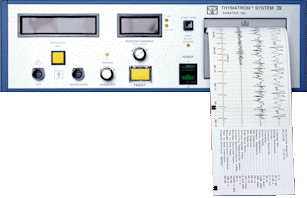|
Description
|

|

|
  EXTENDED LOWER STIMULUS RANGE--ULTRABRIEF STIMULATION EXTENDED LOWER STIMULUS RANGE--ULTRABRIEF STIMULATION |
| Pulsewidth and frequency settings down to Ultrabrief and 20 Hz allow you to deliver stimuli up to 8 seconds long across the entire dosage range, to optimize treatment in accordance with research showing greater efficacy of short-pulsewidth, low-frequency, extended-duration stimuli (Isenberg et al, 1996; Chanpattana, 2001). |
 |
  POSTICTAL SUPPRESSION INDEX POSTICTAL SUPPRESSION INDEX |
| The Postictal Suppression Index reports the degree of EEG flattening immediately following the seizure, which has been reported to correlate with clinical efficacy (Nobler et al, 1993; Krystal & Weiner, 1994; Krystal et al, 1995; Krystal, 1998; Suppes et al, 1996; Petrides et al, 2000; Perera et al, 2002). |
 |
|
  STATE-OF-THE-ART MONITOR/PRINTER STATE-OF-THE-ART MONITOR/PRINTER |
| Allows you to monitor EEG1, EEG2, EKG, and EMG (or, choose 4 channels of EEG), plus 2 derived channels: digital heart rate and anesthesia depth index, while providing hard-copy documentation for the patient's chart. |
 |
  IMPROVED FRONT-PANEL FLEXDIAL© SELECTOR IMPROVED FRONT-PANEL FLEXDIAL© SELECTOR |
| Lets you select all the traditional Thymatron® functions plus important new ones, including Ultrabrief pulse stimulation and programs that automatically set the most effective combination of stimulus parameters at any stimulus dose you have selected. |
 |
|
  EXPANDED, COMPREHENSIVE END-OF-TREATMENT REPORT EXPANDED, COMPREHENSIVE END-OF-TREATMENT REPORT |
| Now includes, in addition to the familiar Thymatron® DGx measures, your choice of the following measures unique to the Thymatron® System IV: |
 |
| EEG COHERENCE MEASURES of maximum sustained coherence and time to peak coherence, interhemispheric cross-correlation measures reported to reflect seizure quality and clinical impact (Roemer et al, 1990-91; Krystal & Weiner, 1994; Krystal et al, 1995; Krystal, 1998; Perera et al, 2002). |
 |
|
| EEG AMPLITUDE MEASURES of maximum sustained EEG power, and time to peak power, with separate values for early, mid- and postictal seizure phases, found by the Columbia and Duke University groups to be important correlates of seizure quality and efficacy (Nobler et al, 1993, 2000; Krystal & Weiner, 1994; Krystal et al, 1995; Suppes et al, 1996; Krystal, 1999; Perera et al, 2002). |
 |
| HEART RATE MEASURES, including peak heart rate, a key measure of cerebral seizure duration and quality (Larson, Swartz, & Abrams, 1984; Swartz, 1993; 1996) that reflects the autonomic (brainstem) response to ECT. This is supplemented by continuous digital heart rate monitoring for safety and seizure generalization, with the result printed each second on the recording strip. |
 |
|
  A POWERFUL 32-BIT INTERNAL COMPUTER A POWERFUL 32-BIT INTERNAL COMPUTER |
| Employs Power Spectral Analysis (FFT) to process and store up to 10 minutes of digitized EEG for the special features described here. You can send this data to any WINDOWS computer via a rear-panel serial port for further comprehensive EEG analysis. |
 |
  DIGITAL EEG MACHINE FUNCTIONS DIGITAL EEG MACHINE FUNCTIONS |
The Thymatron® System IV has all the functions of a sophisticated 4-CHANNEL DIGITAL EEG MACHINE with frequency, coherence, asymmetry, and power spectral analytic programs. These allow you to record and analyze EEGs in your ECT patients between treatments to measure ECT-induced frontal EEG slowing and other EEG manifestations reported to reflect treatment impact and efficacy (Fink & Kahn, 1957; Roemer et al, 1990-91; Sackeim et al, 1996).
Because each ECT treatment session is STORED IN MEMORY, you can retrieve it if you run out of paper during a treatment -- just slip in another pack after the treatment and press a button for a complete printout. |
 |
|
  PATENTED INDEPENDENT SAFETY MONITOR CIRCUIT AND ALARM PATENTED INDEPENDENT SAFETY MONITOR CIRCUIT AND ALARM |
| Prevents the patient from receiving an excessive electrical dose regardless of the operation of the regular circuits. |
 |
  TRUE EMG RECORDING OF THE MOTOR SEIZURE TRUE EMG RECORDING OF THE MOTOR SEIZURE |
| Unlike simple movement detectors, the Thymatron® System IV's EMG can measure seizure muscle activity that is not visible to the naked eye, and which typically continues substantially longer than visible movements (Couture et al, 1988). |
 |
|
  JUST SET ACCORDING TO AGE AND TREAT JUST SET ACCORDING TO AGE AND TREAT |
| Setting the Thymatron® System IV according to the patient's age facilitates easy selection of a stimulus charge for unilateral, bitemporal, or bifrontal ECT that is in the preferred range (Beale et al, 1994; Petrides & Fink, 1996). The single dosage dial configuration also facilitates rapid stimulus titration using the latest age-based titration steps. |
 |
  EASY ON-SITE UPGRADES EASY ON-SITE UPGRADES |
| Because the special computer-automated programs of the Thymatron® System IV are stored on REPLACEABLE MICROCHIPS, future system updates (there have been SEVERAL already) can easily be accomplished via chip replacement. |
 |
|
  SEIZURE ENERGY INDEX SEIZURE ENERGY INDEX |
| A new, improved Average Seizure Energy Index measures a dimension of the seizure -- its intensity -- that is not reflected in seizure duration (Nobler et al, 1993, 2000; Krystal & Weiner, 1994; Krystal et al, 1995; Suppes et al, 1996; Krystal, 1999; Perera et al, 2002). |
 |
  PRINTOUT OF SEIZURE DURATION BY EEG, EMG, AND EKG CRITERIA PRINTOUT OF SEIZURE DURATION BY EEG, EMG, AND EKG CRITERIA |
| The Thymatron® System IV measures the EEG, EMG, and EKG, and automatically prints the corresponding seizure duration estimates with precision and reliability Larson, Swartz and Abrams, 1984; Swartz et al, 1994; Krystal et al, 1995). |
 |
|
  THE PATENTED AUDIBLE EEG© THE PATENTED AUDIBLE EEG© |
| Provides continuous EEG monitoring even if the recording paper runs out. It correlates highly with the visual EEG and keeps you constantly aware of the progress of the EEG seizure without having to watch the recording (Swartz & Abrams, 1986). |
 |
  EXTENDED SEIZURE ALERT EXTENDED SEIZURE ALERT |
| Because longer seizures generate more cognitive side-effects, may clinicians prefer to terminate seizures that exceed 120 to 180 seconds on the EEG (Abrams, 2002). To advise the clinician that this point has been reached, the Thymatron® System IV provides an intermittent click tone when a user-selected interval has elapsed after the stimulus and monitoring has not been terminated. |
 |
|
  RAPID STIMULUS TITRATION RAPID STIMULUS TITRATION |
| Is facilitated with the Thymatron® System IV using a simple method-of-limits procedure (McCall et al, 1993; Rasmussen et al, 1994) or the newest method using age-based titration steps. |
 |

|
|
|

